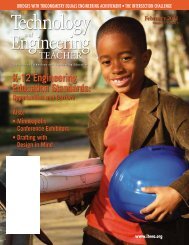Teaching Elements and Principles of Bridge Design - International ...
Teaching Elements and Principles of Bridge Design - International ...
Teaching Elements and Principles of Bridge Design - International ...
Create successful ePaper yourself
Turn your PDF publications into a flip-book with our unique Google optimized e-Paper software.
FEATURE ARTICLE<br />
education teachers can be proactive<br />
by creating innovative ways to<br />
educate individuals about the<br />
complexities <strong>of</strong> technological literacy.<br />
More importantly, teachers can also<br />
be proactive by informing individuals<br />
who are responsible for m<strong>and</strong>ating<br />
NCLB policies that technological<br />
concepts are present in academic<br />
st<strong>and</strong>ards (i.e., mathematics,<br />
science, <strong>and</strong> language arts, as well<br />
as history, <strong>and</strong> geography), which are<br />
<strong>of</strong>ten not found in corresponding<br />
curricula (NAE & NRC, 2002).<br />
Each technology education teacher<br />
should grasp this as an opportunity to<br />
devise creative ways to educate<br />
community members <strong>and</strong><br />
administrators about how these<br />
technological concepts are delivered<br />
effectively in the technology<br />
education classroom. Interestingly, if<br />
successful this also opens a “back<br />
door” for teachers to educate local<br />
administration about the holistic<br />
dimensions <strong>of</strong> TL.<br />
Students as an Alliance for TL<br />
There is no one sure model, method,<br />
or strategy for advocating TL. Each<br />
demographic area has different<br />
educational needs, <strong>and</strong> access to<br />
technology varies. However, every<br />
teacher can start with those they<br />
know best—his/her students. If<br />
students are excited about what they<br />
are learning, they may be a teacher’s<br />
greatest advocates when introducing<br />
the holistic meaning <strong>of</strong> technological<br />
literacy to parents <strong>and</strong> the<br />
community.<br />
Educators can empower students<br />
with what they learn in the<br />
technology education classroom by<br />
involving them in educating parents<br />
<strong>and</strong> the community about TL. For<br />
example,<br />
1. Put students in groups <strong>of</strong> 4-5.<br />
2. On a note card ask students to<br />
write a definition <strong>of</strong> TL.<br />
3. After each student has finished<br />
writing his/her definition, he/she<br />
is to share his/her work with the<br />
others in the group.<br />
4. The students are required to write<br />
a group definition <strong>of</strong> TL.<br />
5. Ask each group to read its<br />
definition.<br />
6. Write the definitions on a piece <strong>of</strong><br />
chart paper.<br />
7. As a class, create a final<br />
definition.<br />
8. Debrief the students by<br />
discussing any <strong>of</strong> the three<br />
dimensions that may have been<br />
overlooked in the definition. The<br />
terminology in the definition<br />
should be relevant to the students<br />
but also include the dimensions <strong>of</strong><br />
knowledge, ways <strong>of</strong> thinking <strong>and</strong><br />
acting, capabilities. 1<br />
After students have grasped the<br />
meaning <strong>of</strong> technological literacy,<br />
introduce reasons why being<br />
technologically literate in the twentyfirst<br />
century is so important. Table 1<br />
outlines potential st<strong>and</strong>ards-based<br />
activities that involve students in<br />
targeting specific audiences (parents,<br />
the community, <strong>and</strong> administration)<br />
in creating TL resources.<br />
Table 1. Communications activities for advocating technological literacy<br />
Target<br />
Audience<br />
STL Benchmarks 2<br />
Activity<br />
<strong>Design</strong> Considerations<br />
Dissemination<br />
Parents<br />
Community<br />
Faculty <strong>and</strong><br />
Administration<br />
STL 17 – J<br />
The design <strong>of</strong> a<br />
message is<br />
influenced by such<br />
factors as the<br />
intended audience,<br />
medium, purpose<br />
<strong>and</strong> nature <strong>of</strong> the<br />
message.<br />
STL 17 – N<br />
Information <strong>and</strong><br />
communication can<br />
be used to inform,<br />
persuade, entertain,<br />
control, manage,<br />
<strong>and</strong> educate.<br />
Create a brochure for<br />
parents that defines TL<br />
<strong>and</strong> the importance <strong>of</strong><br />
being technologically<br />
literate.<br />
<strong>Design</strong> <strong>and</strong> create a<br />
poster that that will<br />
describe TL so that<br />
community members<br />
will underst<strong>and</strong> what it<br />
entails.<br />
Create a brochure that<br />
will describe TL so that<br />
other teachers <strong>and</strong><br />
school board <strong>of</strong>ficials<br />
will underst<strong>and</strong> what it<br />
entails.<br />
Who is the audience?<br />
What misconceptions may parents have<br />
when they think <strong>of</strong> TL?<br />
What needs to be included in the message<br />
to make it stronger <strong>and</strong> in turn have an<br />
impact on parents?<br />
Who is the audience?<br />
What misconceptions may the community<br />
have when they think <strong>of</strong> TL?<br />
What needs to be included for the message<br />
to have a stronger impact on the<br />
community?<br />
Who is the audience?<br />
What misconceptions may teachers <strong>and</strong><br />
school board <strong>of</strong>ficials have when they think<br />
<strong>of</strong> TL?<br />
What needs to be included in the message<br />
to make it stronger <strong>and</strong> in turn have an<br />
impact on the teachers <strong>and</strong> school board<br />
<strong>of</strong>ficials?<br />
• Parent/teacher<br />
conferences<br />
• PTA meetings<br />
• School Open Houses<br />
Bulletin boards:<br />
• Within the school<br />
• At local retail <strong>and</strong><br />
grocery stores<br />
• At local businesses<br />
• In health clinic<br />
waiting rooms<br />
• Faculty lunchroom<br />
• School Board<br />
meetings<br />
• Faculty mailroom<br />
1 Activity adapted from an activity used in the TACKLE (Technology Action Coalition to Kindle Lifelong Equity) Box Institute, UW-Stout, Menomonie, WI,<br />
2000.<br />
2 From <strong>International</strong> Technology Education Association (2000/2002) St<strong>and</strong>ards for technological literacy: Content for the study <strong>of</strong> technology.<br />
THE TECHNOLOGY TEACHER • April 2005 29
















